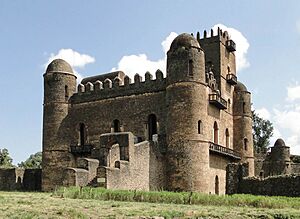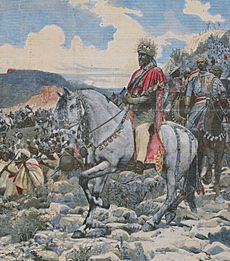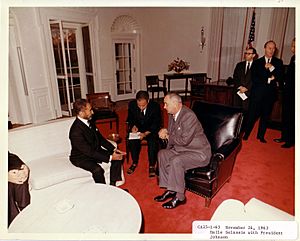Ethiopian Empire facts for kids
Quick facts for kids
Ethiopian Empire
መንግሥተ ኢትዮጵያ (Ge'ez)
Mängəśtä ʾItyop̣p̣ya የኢትዮጵያ ንጉሠ ነገሥት መንግሥት (Amharic) Yäʾityop̣p̣ya Nägusä Nägäst Mängəśt |
|||||||||
|---|---|---|---|---|---|---|---|---|---|
| 1270–1974 1936–1941: Government-in-exile |
|||||||||
|
|
|||||||||
|
Motto: ኢትዮጵያ ታበፅዕ እደዊሃ ኀበ እግዚአብሔር
Ityopia tabetsih edewiha ḫabe Igziabiher (English: "Ethiopia Stretches Her Hands unto God") (Psalm 68:31) |
|||||||||
|
Anthem:
ኢትዮጵያ ሆይ ደስ ይበልሽ Ityoṗya hoy des ybelish (English: "Ethiopia, Be happy") |
|||||||||
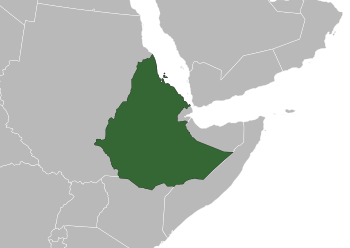
The Ethiopian Empire boundaries in 1952
|
|||||||||

The location of the Ethiopian Empire during the reign of Yohannes IV (dark orange) compared with modern day Ethiopia (orange)
|
|||||||||
| Capital | None (1270–1635) Gondar (1635–1855) Debre Tabor (1855–1881) Mekelle (1881–1889) Addis Ababa (1889–1974) |
||||||||
| Common languages | Amharic (dynastic, official, court) Ge'ez (liturgical language, literature) many others |
||||||||
| Religion |
|
||||||||
| Demonym(s) | Endonym: Ethiopian Exonym: Abyssinian | ||||||||
| Government | Absolute monarchy (1270–1931) Unitary parliamentary constitutional monarchy (1931–1974) |
||||||||
| Emperor | |||||||||
|
• 1270–1285 (first)
|
Yekuno Amlak | ||||||||
|
• 1930–1974 (last)
|
Haile Selassie | ||||||||
| Prime Minister | |||||||||
|
• 1909–1927 (first)
|
Habte Giyorgis | ||||||||
|
• 1974 (last)
|
Mikael Imru | ||||||||
| Legislature | None (rule by decree) (until 1931) Parliament (1931–1974) |
||||||||
| Senate (1931–1974) |
|||||||||
| Chamber of Deputies (1931–1974) |
|||||||||
| Historical era | Middle Ages to Cold War | ||||||||
|
• Ascension of Yekuno Amlak
|
1270 | ||||||||
|
• Conquests of Amda Seyon I
|
1314–1344 | ||||||||
| 1529–1543 | |||||||||
|
• Gondarine period
|
1632–1769 | ||||||||
| 1769–1855 | |||||||||
|
• Menelik II's conquests
|
1878–1904 | ||||||||
| 1895–1896 | |||||||||
|
• Constitution adopted
|
16 July 1931 | ||||||||
|
• Second Italo-Ethiopian War (annexed into Italian East Africa)
|
3 October 1935 | ||||||||
| 5 May 1941 | |||||||||
|
• Federation of Ethiopia and Eritrea
|
11 September 1952 | ||||||||
|
• Coup d'état by the Derg
|
12 September 1974 | ||||||||
| 21 March 1975 | |||||||||
| Area | |||||||||
| 1954 | 1,221,900 km2 (471,800 sq mi) | ||||||||
| Currency |
|
||||||||
|
|||||||||
| Today part of | Eritrea Ethiopia |
||||||||
The Ethiopian Empire, also known as Abyssinia, was a powerful country in Africa. It included the lands of modern-day Ethiopia and Eritrea. This empire lasted for a very long time, from about 1270 to 1974.
It began when the Solomonic dynasty took power under Yekuno Amlak. This ruling family believed they were related to the famous King Solomon and the Queen of Sheba. The empire ended in 1974 with a military takeover by a group called the Derg. This event removed the last Emperor, Haile Selassie, from power.
In the late 1800s, Emperor Menelik II greatly expanded the empire's size. Later, in 1952, Eritrea joined with Ethiopia under Emperor Haile Selassie's rule. Even though it faced many challenges from surrounding groups, the Ethiopian Empire kept its strong Christian traditions.
History of the Ethiopian Empire
How the Empire Began
After the Kingdom of Aksum fell around the year 900 AD, the Zagwe Dynasty ruled the Ethiopian Highlands. These rulers were from the Agaw people. Some old religious writings said they were not true descendants of King Solomon.
However, the Zagwe rulers built amazing rock-hewn churches, like those in Lalibela. These buildings showed their connection to earlier Aksumite styles. But the Zagwe kings often fought among themselves for the throne. This fighting weakened their power.
By the late 1200s, a young nobleman named Yekuno Amlak gained power. He was from the Amhara people. The Ethiopian Orthodox Church strongly supported him. He promised the church more independence. Yekuno Amlak fought against the Zagwe king and won the Battle of Ansata.
Early Solomonic Rule
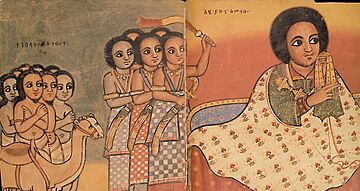
Yekuno Amlak became emperor around 1270 AD. He claimed to be a descendant of the last king of Aksum. This meant he also claimed to be related to the biblical King Solomon. The story of this connection is told in the Kebra Nagast, a book from the 1300s.
This book says that the Queen of Sheba visited King Solomon in Jerusalem. She had a son with him, named Menelik I. Menelik I and his family ruled Ethiopia until the Zagwe took over. Yekuno Amlak was said to be a direct descendant of Menelik I. So, he "restored" the Solomonic line of rulers.
During his rule, Yekuno Amlak had good relationships with Muslim leaders. He built the church of Genneta Maryam. An inscription there says he built it "By the grace of God."
In 1285, Yekuno Amlak's son, Yagbe'u Seyon, became emperor. He asked the Mamluk Sultan in Egypt to send a new leader for the Ethiopian Orthodox Church. He also protested how the Sultan treated Christians in Egypt. Yagbe'u Seyon said he protected his own Muslim subjects in Ethiopia.
Later, his son Wedem Arad took the throne in 1299. He faced conflicts with the nearby Sultanate of Ifat.
Amda Seyon's Expansions
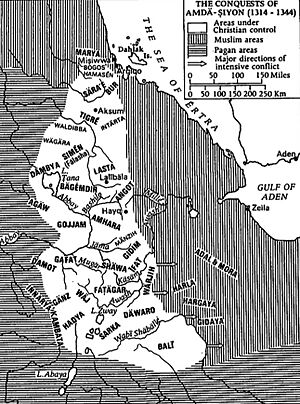
Amda Seyon I became emperor after Wedem Arad. During his rule, detailed records of his military campaigns were written. These were the first of many royal chronicles. They kept a continuous history of the medieval period in the Horn of Africa.
Another important book from his time was the Fetha Nagast, or "Law of the Kings." This book was based on biblical ideas. It set out the laws and social rules of the time. It was used in Ethiopia until the early 1900s.
Emperor Amda Seyon I was a strong military leader. He led many campaigns in different regions. His most important campaigns were against Muslim groups to the east. These wars changed the balance of power, favoring Christians for the next two centuries.
Around 1320, the Sultan in Egypt began to harm Christians. Amda Seyon threatened to change the flow of the Nile River if the Sultan did not stop. Later, a Muslim leader named Haqq ad-Din I captured an Ethiopian messenger. Amda Seyon responded by invading the Sultanate of Ifat. He defeated the sultan and damaged Muslim towns.
Another Muslim leader, Sabr ad-Din I, then led a rebellion. Amda Seyon launched another campaign, defeating the sultan and reaching far into eastern Ethiopia. Amda Seyon's victories greatly expanded the Ethiopian Empire. It more than doubled in size. This gave Ethiopia complete control over the region.
Golden Age of Solomonic Rule
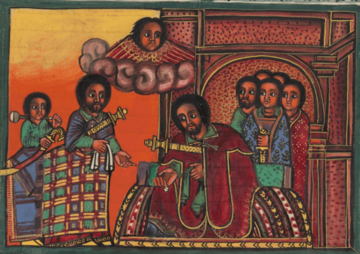
After Amda Seyon's campaigns, most Muslim areas in the Horn of Africa paid tribute to the Ethiopian Empire. Newaya Krestos became emperor in 1344. He stopped several Muslim revolts. He also helped the Christian leader in Egypt, who had been imprisoned. Newaya Krestos imprisoned Egyptian merchants in his kingdom. This forced the Sultan to release the Christian leader.
In 1382, Dawit I became emperor. The Ifat Sultanate began to fight against Ethiopian rule. Its leader, Sultan Sa'ad ad-Din II, raided Ethiopian lands. Emperor Dawit I then declared all Muslims in the area "enemies of the Lord." He invaded the Ifat Sultanate.
The Ethiopian army defeated Sa'ad ad-Din's forces. They chased him to Zeila on the coast. The Ethiopian army captured Zeila and killed Sultan Sa'ad ad-Din. This ended the Ifat Sultanate. After this victory, Ethiopia became very powerful. This time was known as a golden age of peace and stability.
However, the Walashma family returned in 1415. They formed the Adal Sultanate near Harar. This new sultanate began to attack Christian lands. Emperor Yeshaq I spent much of his time defending his eastern borders. He was killed fighting the Adalites in 1429.
After Yeshaq's death, there was confusion about who would rule. But in 1434, Zara Yaqob became emperor. He worked to stop pagan worship and non-Christian practices. He also made the government more centralized. He built a church named Debre Mitmaq.
When the Egyptian Sultan harmed the Christian leader in Egypt, Zara Yaqob protested. He threatened to change the flow of the Nile. The Sultan then encouraged the Adal Sultanate to invade Ethiopia. Zara Yaqob's army pushed back this invasion. Zara Yaqob later founded Debre Berhan after seeing a miraculous light in the sky. He built a church and a palace there.
Zara Yaqob was followed by Baeda Maryam I. His mother, Eleni of Ethiopia, was a very important member of the royal family. She tried to make peace with the Adal Sultan. But the Emir of Harar, Mahfuz, continued to raid Ethiopian lands.
When Emperor Eskender was old enough, he invaded Adal. But he was killed on his way home. His successor, Emperor Na'od, was also killed defending Ethiopia. In 1517, Mahfuz invaded Ethiopia again. But Emperor Dawit II (Lebna Dengel) defeated and killed him. People believed the Muslim threat was over.
Adal Sultanate Invasion
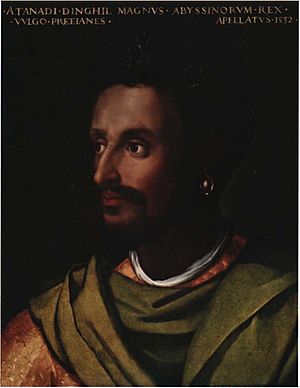
In 1527, a young leader named Ahmad ibn Ibrahim al-Ghazi (also known as Gragn) rose to power in Adal. The Adal Sultanate gathered many firearms and cannons from Arabia and the Ottoman Empire. Gragn invaded Ethiopia in 1529. He defeated Emperor Dawit II, but then pulled back.
Two years later, he launched a full invasion. His forces burned churches and forced Christians to convert. They caused great suffering to the people. By the mid-1530s, most of Ethiopia was under Adalite control. Lebna Dengel had to flee from one mountain fortress to another. He died of natural causes in Debre Damo.
His 18-year-old son, Gelawdewos, became emperor. He faced a very difficult situation. But he gathered his soldiers and people to fight the Muslim invasion. In 1541, four hundred well-armed Portuguese soldiers arrived in Massawa. They joined with Ethiopian warriors. This small force defeated larger Adalite groups.
Gragn was worried by the Portuguese success. He asked the Ottoman Empire for help. He received 2,900 soldiers with muskets. With his Turkish allies, Gragn attacked the Portuguese at the Battle of Wofla. Many Portuguese soldiers were killed, including their commander.
After this defeat, the remaining Portuguese joined Gelawdewos's army. The Emperor attacked and won a major victory at the Battle of Wayna Daga. The Adalite leader, Gragn, was killed. His army fled. The invasion collapsed, and Christian lands were taken back.
In 1559, Gelawdewos was killed while trying to invade the Adal Sultanate.
Early Modern Period
The Ottoman Empire took control of parts of Ethiopia starting in 1557. They captured Massawa, Ethiopia's main port. Emperor Sarsa Dengel defeated the Ottomans in 1589. This kept them to a narrow coastal strip.
During this time, the Oromo migrations also occurred. Large groups of people moved from the southeastern parts of the Empire. This led to changes in the empire's organization. Faraway provinces became more independent.
In 1636, Emperor Fasilides made Gondar the permanent capital. Gondar became a stable and wealthy trading center. This period, known as the Gondarine period, saw great achievements in Ethiopian art and architecture. Many churches were built around Lake Tana. Artworks like paintings and illustrated books were created, mostly with religious themes.
The rule of Iyasu the Great (1682-1706) was a time of strong leadership. He sent representatives to France and Dutch India. After Iyasu I died, the empire faced political problems.
Modern Era and Challenges
From 1769 to 1855, Ethiopia went through a time called the Princes Era (Zemene Mesafint). During this period, local warlords fought for power. The Emperor had very little power and only controlled the area around the capital, Gondar. Society and culture did not grow much. Religious conflicts also caused problems.
Emperor Tewodros II (1855–1868) ended the Princes Era. He reunited the Empire and brought it into modern times. He died during the British Expedition to Abyssinia. His successor, Yohannes IV, fought successfully against the Egyptians and Mahdists. He died fighting the Mahdists in 1889.
Emperor Menelik II, who lived in Addis Ababa, conquered many lands in western, southern, and eastern Ethiopia. By 1898, Ethiopia had expanded to its modern borders. In the north, he faced Italy's expansion.
Italy wanted to create colonies in Africa. They were given Eritrea by Britain. This led to conflicts between Emperor Yohannes IV and Italy. After Yohannes IV died, Italy signed a treaty with Shewa. Italy believed this treaty made Ethiopia a protectorate. However, the Italian and Amharic versions of the treaty were different. Menelik II said Ethiopia was not a protectorate in 1893.
Italy declared war on Ethiopia in 1895. The First Italo-Ethiopian War ended with the Battle of Adwa in 1896. Ethiopia decisively defeated Italy. Ethiopia had modern weapons, which surprised the Italians. The Treaty of Addis Ababa was signed, setting the borders of Eritrea. Italy had to recognize Ethiopia's independence.
European countries like the United Kingdom and France then sent representatives to Ethiopia. They wanted to make their own treaties with this newly powerful nation.
Italian Invasion and World War II
In 1935, Italian soldiers invaded Ethiopia in the Second Italo-Ethiopian War. The war lasted seven months. Italy won and occupied Ethiopia. They combined it with their other colonies to form Italian East Africa. The League of Nations condemned the invasion, but did little to stop it.
During the war, Italian troops used harmful gases, ignoring international agreements. Many people were harmed by these gases. Italy then annexed Ethiopia. Victor Emmanuel III of Italy took the title "Emperor of Abyssinia."
In 1940, Italy joined World War II. They declared war on the United Kingdom and France. Emperor Haile Selassie returned to Ethiopia from England to help lead the resistance. In 1941, British forces, with Ethiopian freedom fighters, drove the Italians out. Italian rule ended in November 1941.
Ethiopia After World War II
On August 27, 1942, Haile Selassie ended slavery throughout the empire. He set strict punishments for slave trading. After World War II, Ethiopia became one of the first members of the United Nations. In 1950, the UN decided that Eritrea would join Ethiopia. Eritrea would have its own government, but Ethiopia would handle its money, defense, and foreign policy.
Haile Selassie tried to make many changes. He wanted to reform taxes, but the nobles and church leaders resisted. Ethiopia was still a "semi-feudal" society. This meant that landowners had a lot of power. The tax burden mostly stayed on the peasants.
Between 1941 and 1959, Haile Selassie worked to make the Ethiopian Orthodox Tewahedo Church more independent. Before, its leader answered to the church in Egypt. In 1959, the Ethiopian Church gained its own Patriarch. Haile Selassie also started taxing church lands.
In 1955, Haile Selassie introduced a new constitution. He kept most of the power, but allowed people to elect members to the lower house of parliament. Modern education spread, and the country began plans for modernization. However, his reforms to end feudalism were slow.
In 1960, while Haile Selassie was away, some of his Imperial Guard tried to take over the government. This attempt failed. But it showed that people were starting to question the emperor's power. Students began to support the poor. This led Haile Selassie to speed up some reforms.
The emperor remained a strong ally of Western countries. He also worked to end colonialism in Africa. In 1963, Haile Selassie helped create the Organisation of African Unity (OAU). This organization worked for African unity. Its headquarters were in Addis Ababa. Haile Selassie was elected its first chairperson.
Student protests became common in the 1960s and 1970s. Many educated Ethiopians became interested in Marxism. Resistance from conservative groups made it hard for Haile Selassie to make land reforms. This made many peasants unhappy. As problems grew, Haile Selassie focused more on foreign affairs.
Fall of the Monarchy
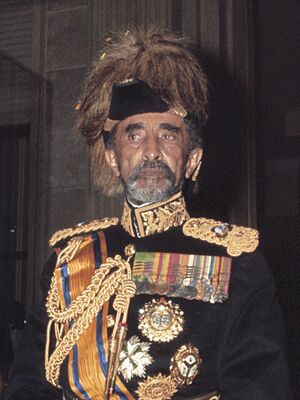
In 1973, a severe famine hit the Wollo region. The government did not respond well. This, along with unhappiness among city groups and high fuel prices, led to a revolt in February 1974. A group of military officers formed the Derg in June. They wanted to keep order because the civilian government was losing power.
In July, Emperor Haile Selassie allowed the Derg to arrest military and government officials. Many former prime ministers, governors, and military officers were imprisoned. In August, the Derg began to dismantle the imperial government. They wanted to prevent a constitutional monarchy.
The Derg removed and imprisoned the Emperor on September 12, 1974. They chose Lieutenant General Aman Andom as the temporary head of state. He was supposed to hold power until the Crown Prince could return and become a constitutional monarch. However, General Aman disagreed with the radical members of the Derg. He did not want a new military attack in Eritrea or the execution of former officials.
After removing units loyal to him, the Derg removed General Aman from power. They executed him on November 23, 1974. They also executed some of his supporters and 60 officials from the previous government.
Brigadier General Tafari Benti became the new head of the Derg and the state. The monarchy was officially ended in March 1975. A new political idea, Marxism-Leninism, was declared for the state. Emperor Haile Selassie died under mysterious circumstances on August 27, 1975. Many believe Mengistu Haile Mariam was responsible for his death.
Society
In the 1500s, Ethiopian society had different groups. These included monks, religious scholars, judges, and soldiers who protected royal wives. There were also landowners called shimaglle, their farm workers, traders, artisans, and wandering singers.
Power was held by the Emperor and the nobles he appointed. Soldiers were important for enforcing the Emperor's power.
Military
From the time of Emperor Amde Tseyon, special groups of soldiers called Chewa regiments were the main part of the Empire's army. These regiments usually had thousands of men. Each regiment was given land (called a Gult). The money from this land helped support the soldiers.
In 1445, Emperor Zara Yaqob began placing Chewa regiments in different provinces.
| Name of regiment | Region | Meaning |
|---|---|---|
| Bäṣär waǧät | Serae, Dawaro, Menz, Gamo | Enemy of the waǧät |
| Ǧan amora | Dobe'a, Tselemt, Gedem | Eagle of the majesty |
| Ǧan sagana | Dawaro, Dobe'a, Angot | |
| č̣äwa Bale | Bali | |
| č̣äwa Maya | Medre Bahr | |
| Bäṣur amora | Gamo | Spear of the eagle |
| Bäṣär šotäl | Damot | Spear of the foe |
| č̣äwa Begemder | Begemder | |
| č̣äwa Ifat | Ifat |
The army had major divisions:
- Regiments at the Emperor's court, led by high officials.
- Regiments in the provinces, led by regional leaders.
- Regiments in border areas, led by military officials appointed by the king.
One old Chewa regiment, called the Abe Lahm, even fought in the Battle of Adwa. It was removed from service in the 1920s. The modern army was created in 1917, with the formation of the Kebur Zabagna, the imperial guard.
Economy
For centuries, Ethiopia's economy used a barter system. People traded goods directly. They also used "primitive money" like salt bars, cloth, or iron pieces. Real currency only became common in the 19th century.
In 1905, Emperor Menelik II started the first bank, the Bank of Abyssinia. This bank handled government money and printed banknotes. It opened branches in other cities. In 1932, it was renamed "Bank of Ethiopia."
Emperor Haile Selassie tried to boost industry and manufacturing. Between 1960 and 1970, Ethiopia's economy grew by 4.4% each year. Manufacturing also grew. Ethiopia exported wheat to countries like Egypt and Greece.
Currency
In earlier times, common forms of money in Ethiopia included "amole" (salt bars), pieces of cloth, or iron. Later, even cartridges were used. It was not until the 1800s that the Maria Theresa thaler became widely used for large transactions. Emperor Menelik II then began minting local currency around the turn of the 20th century.
Government
The Ethiopian Empire was a feudal system. This meant it had a strong ruler and clear social differences. Land ownership was very important. It drove the empire's expansion, especially under Emperor Menelik II.
Emperor Haile Selassie tried to modernize the government. He introduced new constitutions in 1931 and 1955. These created a system with a parliament that had two parts: the Senate and the Chamber of Deputies.
The Chamber of Deputies had 250 members elected every four years. The Senate had 125 members, who were appointed by the Emperor every six years.
See also
 In Spanish: Imperio etíope para niños
In Spanish: Imperio etíope para niños
- History of Ethiopia
- Emperor of Ethiopia
- List of emperors of Ethiopia
- Zemene Mesafint (1755–1855)
- First Italo-Ethiopian War (1895–1896)
- Second Italo-Ethiopian War (1935–1936)
- Italian East Africa (1936–1941)
- Ethiopian Revolution (1974)





